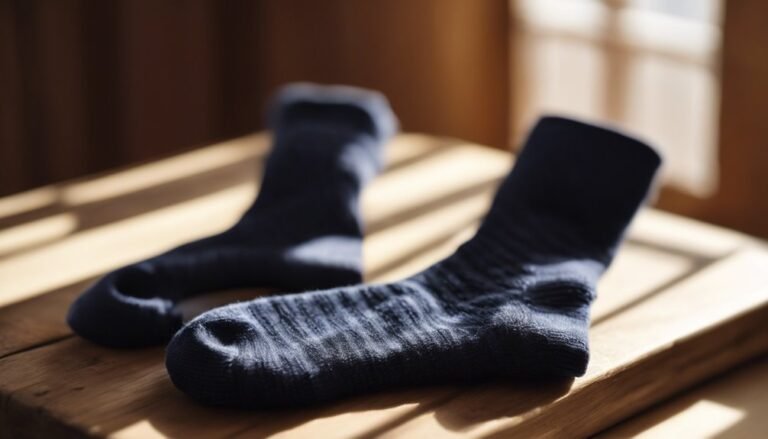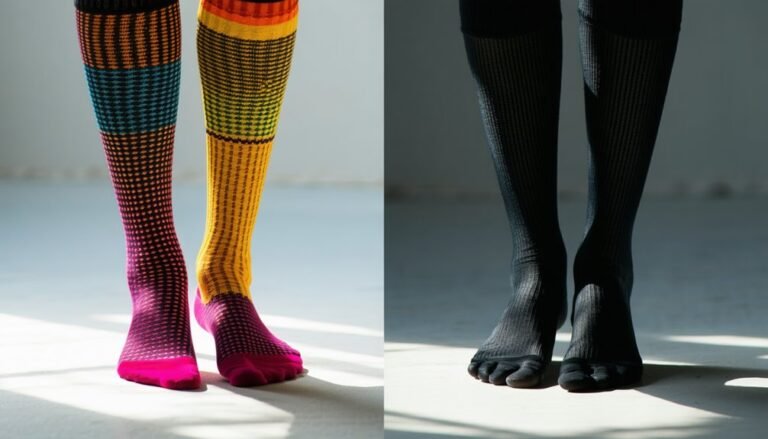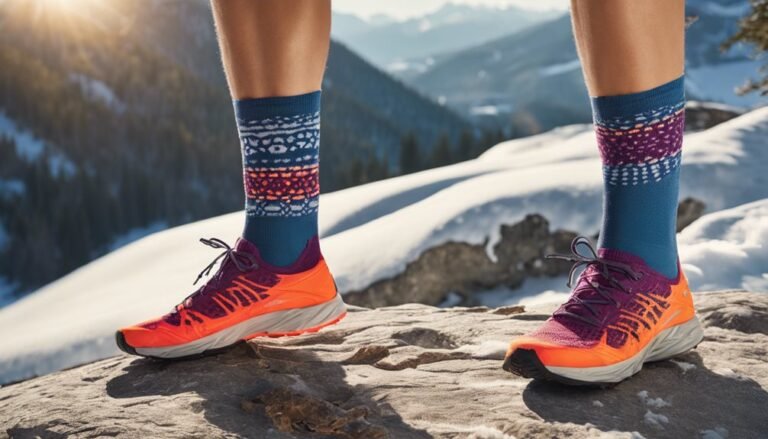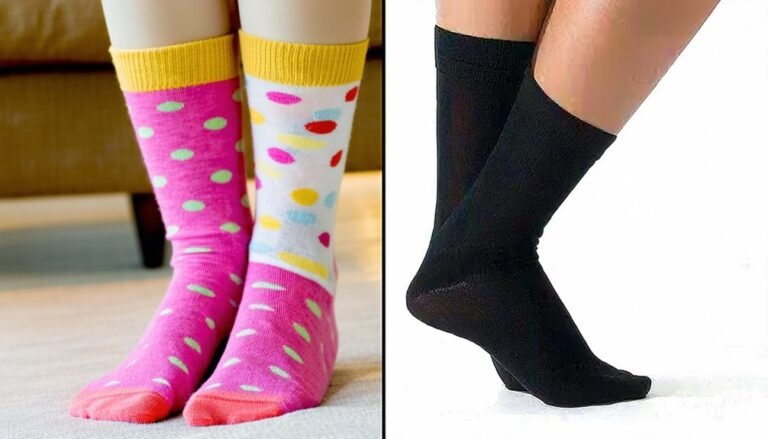How Do Moisture-Wicking Socks Work? Explained
Imagine this: You're in the middle of a long hike, your feet pounding against the rocky terrain, and all you can think about is the discomfort of sweaty, damp socks.
What if there was a way to keep your feet dry and comfortable, no matter how intense the activity? Moisture-wicking socks are the answer.
These innovative socks use specialized fabric technology to draw sweat away from your skin, promoting dryness and comfort. By employing capillary action to lift moisture to the sock's surface and facilitating evaporation, they keep your feet dry.
Made from synthetic fibers like polyester and nylon, these socks resist moisture absorption, improve airflow, and reduce odor and friction.
Curious about how these features can enhance your performance on your next adventure? Let's delve deeper.
Understanding Moisture-Wicking Technology
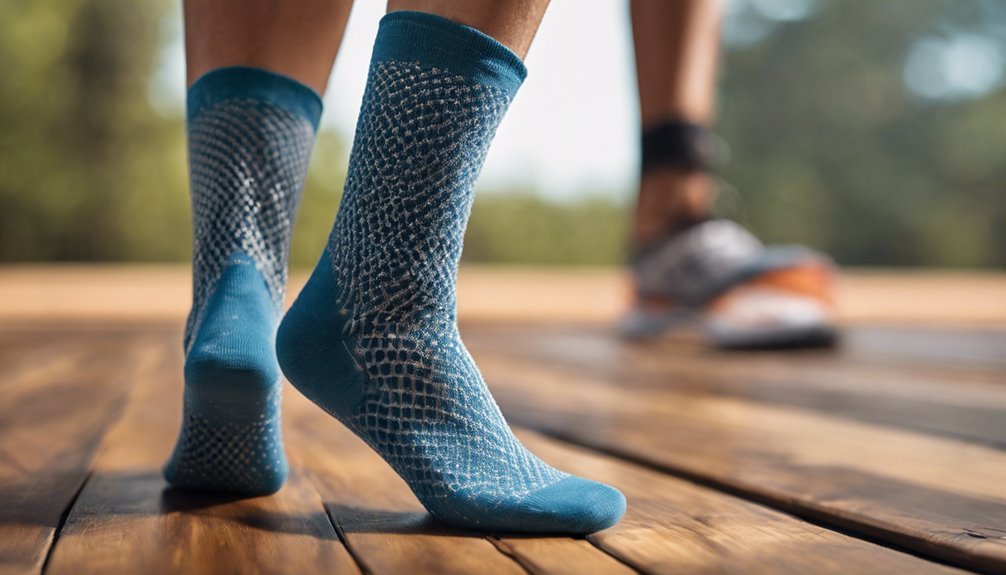
When it comes to moisture-wicking technology, understanding the science behind it can enhance your appreciation for how these socks keep your feet dry. Moisture management is key in achieving ideal sock performance, especially during high-intensity activities where sweat production is inevitable. The technology relies on capillary action, where fibers pull moisture away from your skin to the sock's outer surface. This process guarantees evaporation occurs efficiently, maintaining a dry environment for your feet. Such functionality is essential for comfort and blister prevention, allowing you to move freely and confidently. Additionally, the structure and weave of the sock influence airflow, facilitating quicker drying times. By focusing on these technical aspects, you'll grasp how moisture-wicking socks deliver superior performance and freedom in your activities.
Key Materials Used in Moisture-Wicking Socks
When choosing moisture-wicking socks, you'll encounter a variety of materials, each offering distinct benefits. Synthetic fibers like polyester and nylon are prized for their high moisture transport capabilities, while natural fibers such as merino wool provide breathability and temperature regulation. Blended materials combine these advantages, optimizing both performance and comfort in varying conditions.
Synthetic Fiber Benefits
Although natural fibers have their advantages, the benefits of synthetic fibers in moisture-wicking socks are unparalleled, primarily due to their engineered properties. Synthetic fibers like polyester, nylon, and spandex are crafted for superior moisture management. By quickly transferring sweat from the skin to the exterior of the sock, these fibers guarantee your feet remain dry and comfortable. This process relies on the synthetic durability that withstands repeated washing and wear, maintaining performance over time. The hydrophobic nature of these materials means they repel moisture, facilitating rapid evaporation. Additionally, their lightweight structure doesn't compromise on strength, giving you the freedom to move without restriction. Embrace the advanced technology of synthetic fibers for a sock experience that matches your active lifestyle.
Natural Fiber Advantages
Natural fibers offer distinct advantages in moisture-wicking socks due to their inherent properties and environmental benefits. Cotton, known for its comfort, provides natural breathability, allowing your feet to remain cool and dry. Although traditionally seen as moisture-retentive, advanced cotton technologies now enhance its ability to wick away moisture efficiently. Wool, on the other hand, stands out for its superior moisture management and thermal regulation. Its fibers can absorb up to 30% of their weight in moisture without feeling wet, making it ideal for fluctuating temperatures. Wool's structure also inhibits bacterial growth, reducing odor. For those seeking eco-friendly options, both cotton and wool are renewable resources, offering a sustainable choice while ensuring your feet stay dry and comfortable.
Blended Material Properties
In the domain of moisture-wicking socks, blended materials play an essential role in optimizing performance and comfort. By combining fibers like polyester, nylon, and spandex, these fabric combinations harness the strengths of each material. Polyester excels at moisture management, efficiently moving sweat away from your skin. Nylon enhances durability, guaranteeing your socks withstand rigorous activities. Spandex provides elasticity, allowing for a snug fit that maintains shape over time.
These blended materials create a balanced textile that addresses multiple athletic demands. The synergy of these fibers guarantees that moisture-wicking socks offer breathability and flexibility without sacrificing durability. As an individual seeking freedom in active pursuits, you'll appreciate how these fabric combinations elevate your comfort, maintaining dryness and preventing blisters during prolonged use.
How Moisture-Wicking Fabrics Function
To understand how moisture-wicking fabrics work, you'll need to examine their fiber structure and design, which are engineered to manage moisture efficiently. These fabrics employ a capillary action mechanism, where moisture is drawn away from the skin and dispersed across the fabric's surface. This process enhances evaporation, keeping your feet dry and comfortable.
Fiber Structure and Design
While understanding the intricacies of moisture-wicking fabrics, it is essential to examine the fiber structure and design that enable these materials to function effectively. The fiber composition is fundamental; synthetic fibers like polyester and nylon are often chosen for their hydrophobic properties, which resist moisture absorption. These fibers are engineered with a cross-sectional shape that enhances surface area, promoting quick evaporation. Sock construction plays a significant role too. By strategically knitting or weaving these fibers into patterns that facilitate airflow, moisture is swiftly transported away from the skin. This meticulous design guarantees your feet remain dry and comfortable, providing the freedom to move without restrictions. Understanding these elements empowers you to make informed choices, maximizing performance and comfort.
Capillary Action Mechanism
Building on the understanding of fiber structure and design, one must consider the capillary action mechanism that drives moisture-wicking functionality. Capillary action is the process by which liquid moves through the interstitial spaces of fibers, defying gravity due to surface tension and adhesive forces. This phenomenon is essential for moisture transfer, as it allows sweat to be drawn away from your skin to the outer fabric surface. The fibers' high surface energy interacts with the liquid, propelling it along micro-channels. This movement is not just passive; it's an active pursuit of freedom from dampness. By mastering this mechanism, moisture-wicking socks guarantee your feet remain dry, enhancing comfort and performance. Understanding these dynamics empowers you to make informed choices in your active lifestyle.
Benefits of Wearing Moisture-Wicking Socks
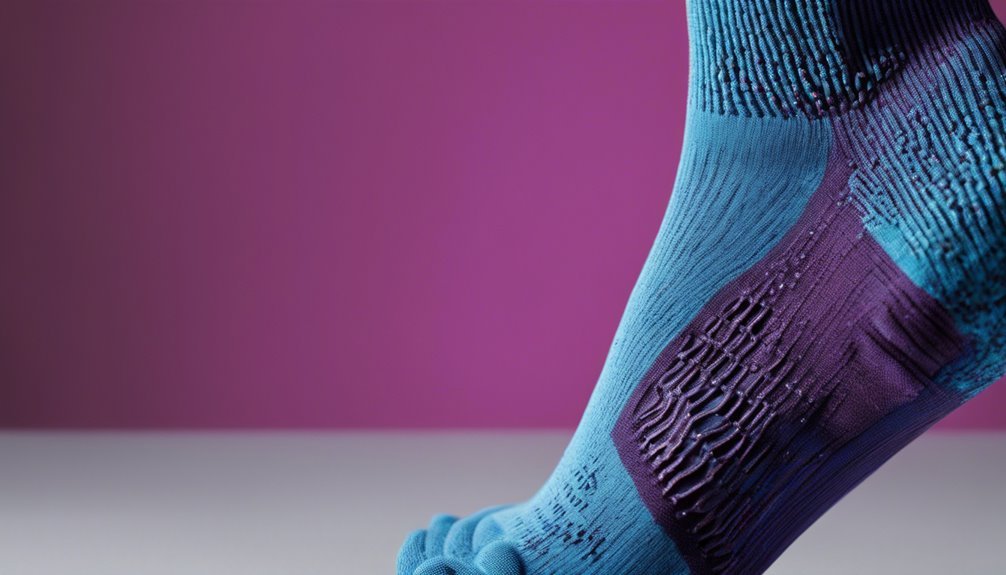
Even though they may seem like a minor accessory, moisture-wicking socks offer significant benefits that can improve both comfort and foot health. By efficiently drawing moisture away from your skin, they enhance performance and reduce odor, allowing you to focus on your activities without distraction. Whether you're running, hiking, or simply on your feet all day, these socks keep your feet dry and comfortable. The table below emphasizes the core advantages:
| Benefit | Description | Impact |
|---|---|---|
| Performance Enhancement | Keeps feet dry, reduces friction | Improved mobility |
| Odor Control | Limits bacterial growth | Fresher feet, longer |
| Comfort | Soft, breathable materials | Enhanced comfort |
| Foot Health | Reduces risk of blisters, infections | Healthier feet overall |
These advantages provide the freedom to engage in any activity with confidence.
Choosing the Right Moisture-Wicking Socks for Your Needs
How do you determine the best moisture-wicking socks for your specific needs? Start by considering sock sizing; proper fit guarantees maximum moisture management. Measure your foot accurately and compare it to the manufacturer's sizing chart. Next, analyze your activity level. High-intensity activities like running or hiking require socks with enhanced breathability and reinforced areas for durability. Conversely, lighter activities might benefit from thinner, more flexible options. Examine the sock's fiber content—synthetic blends often offer superior moisture-wicking capabilities. Assess additional features like cushioning or compression, relevant to your comfort and performance. Ultimately, the ideal pair balances these technical aspects, aligning with your personal preferences and freedom of movement, ensuring that your socks work as hard as you do.
Caring for Your Moisture-Wicking Socks
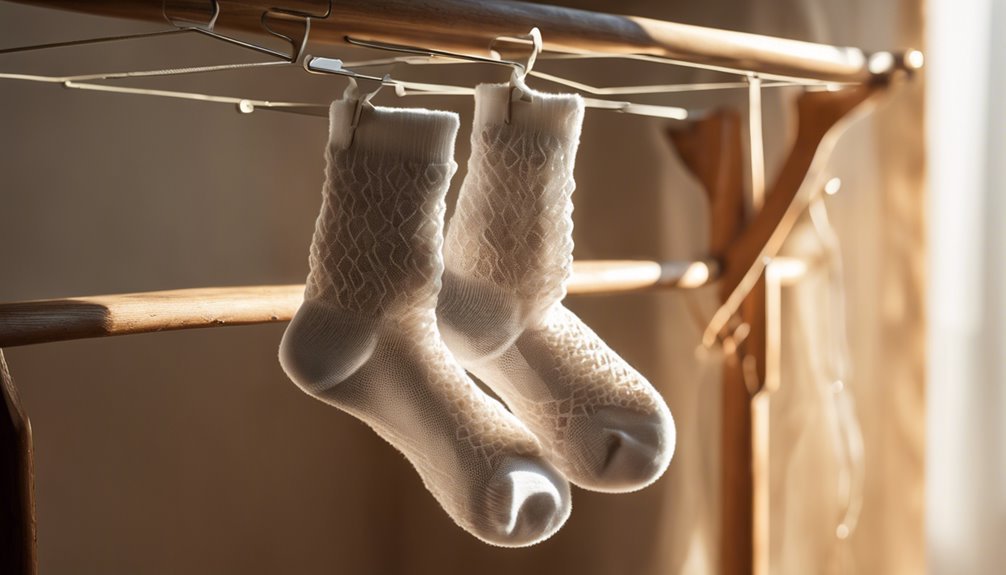
While moisture-wicking socks are designed for durability and performance, proper care is essential to maintain their functionality and lifespan. Begin with sock maintenance by turning them inside out before washing. This prevents pilling and keeps the fibers effective in moisture management. Use cold water and a gentle cycle to preserve the fabric's integrity. Avoid fabric softeners, as they can coat the fibers, reducing their wicking capability. Drying should be low heat or air dry, as high temperatures can damage the elasticity. For best results, follow these washing tips: separate socks by color to prevent dye transfer and avoid overloading the machine, ensuring thorough cleaning. By adhering to these guidelines, you'll enhance your socks' performance and enjoy true freedom in every step.
Frequently Asked Questions
Can Moisture-Wicking Socks Prevent Foot Odor?
You won't believe how moisture-wicking socks can revolutionize your foot hygiene. They're like a tiny army, executing perfect odor control by removing moisture swiftly, allowing your feet to breathe freely, keeping them dry and odor-free all day.
Are Moisture-Wicking Socks Environmentally Friendly?
You're curious if moisture-wicking socks are environmentally friendly. Many eco-friendly brands use sustainable materials like bamboo or recycled fibers. Analyzing their production methods can reveal if they're truly reducing their environmental impact, granting you more freedom in conscious choices.
How Long Do Moisture-Wicking Socks Typically Last?
You're wondering about their lifespan. Moisture-wicking socks' durability depends on factors like material quality and usage frequency. High-quality materials enhance longevity, offering freedom from frequent replacements, letting you focus on adventures without worrying about sock wear.
Do Moisture-Wicking Socks Require Special Laundry Care?
Laundry instructions for moisture-wicking socks aren't arduous. Follow fabric care by washing with cool water, using gentle detergents, and air-drying to guarantee longevity. These steps safeguard your socks, supporting your freedom to enjoy sweat-free adventures.
Are Moisture-Wicking Socks Suitable for All Types of Shoes?
You're wondering if moisture-wicking socks are suitable for all types of shoes. These socks are generally compatible with most footwear, but for best performance, consider the sock compatibility with your activity-specific shoes to guarantee maximum comfort and efficiency.



